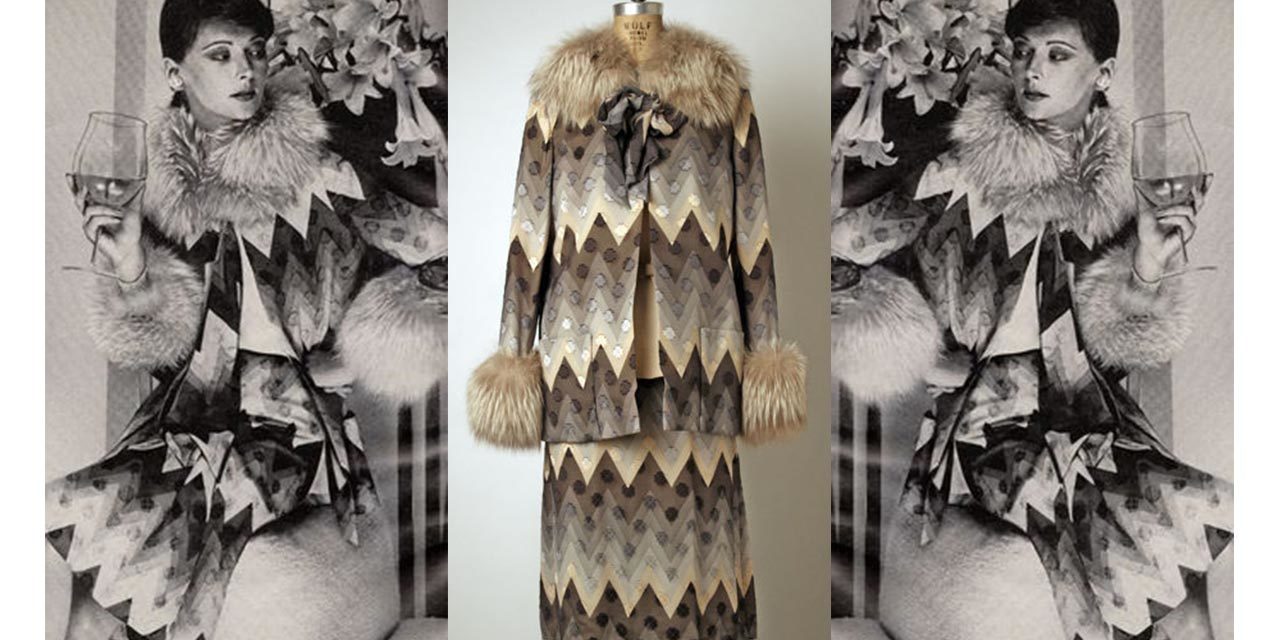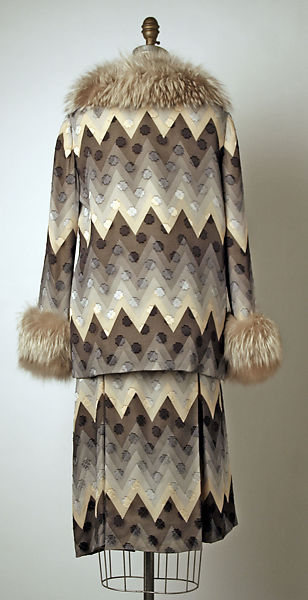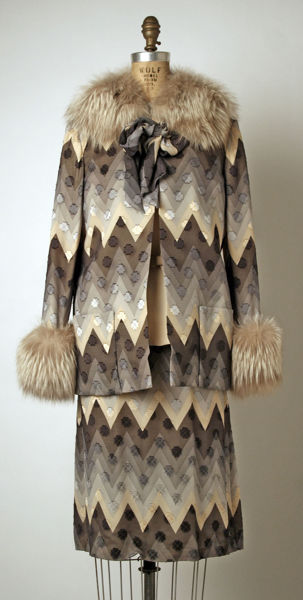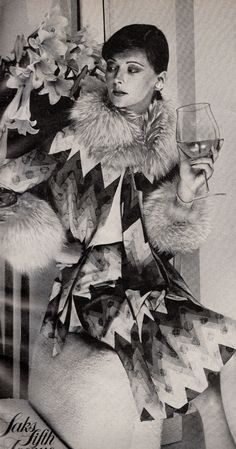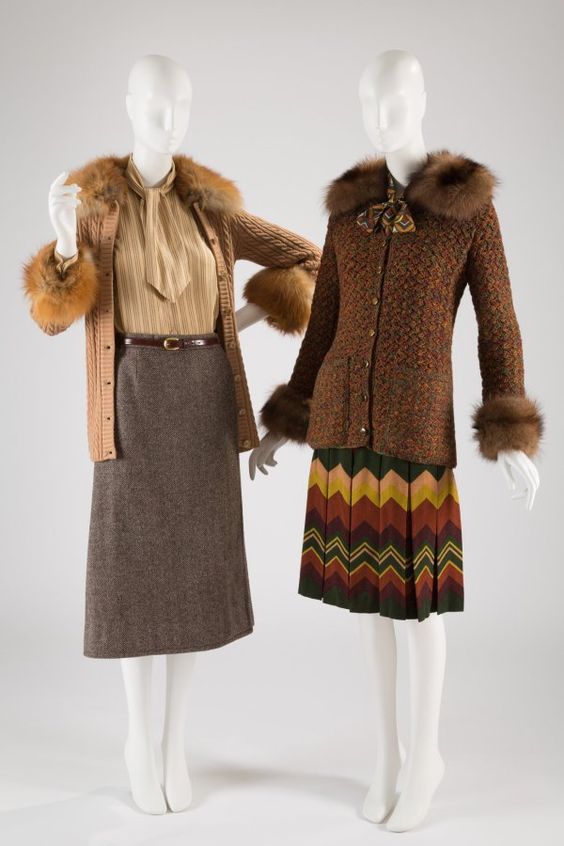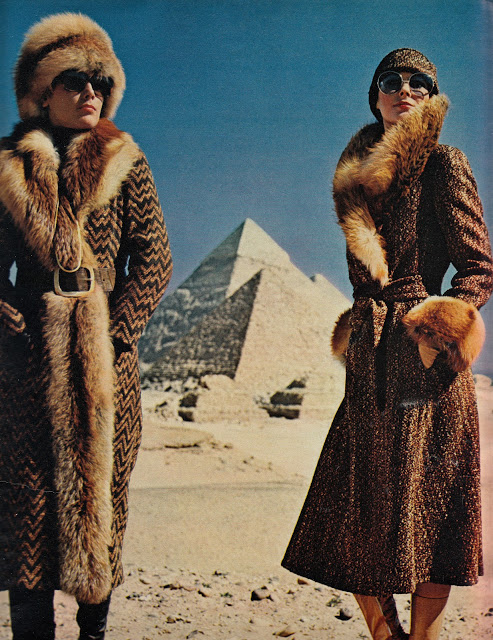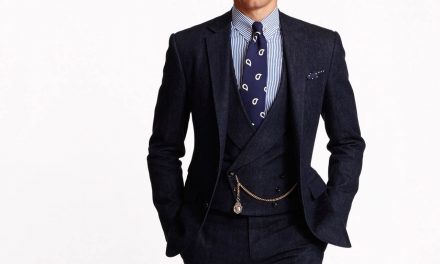The 1970s were marked by a progression towards casual comfort while retaining an aura of chic, a trend Bill Blass embodies in this 1973 evening ensemble that radiates classy comfort.
About the Look
T
his 1973 evening ensemble consists of a tailored jacket, top, and skirt made of silks, leather, and furs. Though the silhouette of the garment is not body-hugging, the piece still has a slimming effect. Underneath the jacket, the skirt is paired with a long-sleeved top belted at the waist (Fig. 1). There is a neutral geometric chevron and polka dot motif throughout the skirt and coat, ranging in colors between white, taupe and brown. Canadian fox fur, which is tan at the tips, is used on the coat at the ends of both sleeves and at the collar. The back of the skirt is made of three panels, with a large but shallow box pleat in the center panel to add some movement (Fig. 2).
Fig. 1 - Bill Blass (American, 1922-2002). Evening ensemble, 1973. Silk and leather. New York: The Metropolitan Museum of Art, 1981.259.1a–d. The Jacqueline Loewe Fowler Costume Collection, Gift of Jacqueline Loewe Fowler, 1981. Source: MMA
Fig. 2 - Bill Blass (American, 1922-2002). Evening ensemble, 1973. Silk and leather. New York: The Metropolitan Museum of Art, 1981.259.1a–d. The Jacqueline Loewe Fowler Costume Collection, Gift of Jacqueline Loewe Fowler, 1981. Source: MMA
Bill Blass (American, 1922-2002). Evening Ensemble, 1973. Silk and leather. New York: The Metropolitan Museum of Art, 1981.259.1a–d. The Jacqueline Loewe Fowler Costume Collection, Gift of Jacqueline Loewe Fowler, 1981. Source: MMA.
About the context
This evening ensemble represents a fashionable and chic outfit for the upper echelon of society. Vogue editor-and-chief Grace Mirabella wrote an article called “Silk and Saks” in September 1973 remarking how the Canadian fox fur and the subtle dotting on the chevron pattern collaborated to produce a lavishly refreshing look when worn (Fig. 3) (27). Mirabella’s description of the piece suggests that the general public viewed Blass’s clothing as chic pieces to create “a million dollar mood,” meaning that women were allowed to satiate their desire to feel rich without looking gaudy and pompous (27).
In Bill Blass: An American Designer (2002), Helen O’Hagan describes Blass’s design:
“There’s a protective quality to his approach to dressing a woman…She can be sexy without being vulgar, festive without being ridiculous, dignified without being dowdy.” (14)
In other words, Bill Blass’s evening ensemble is intended to possess a simple and understated cut with a subtle display of wealth and seduction.
Besides Blass’s desire to dress women in elegantly lavish clothing, his other inspirations for his Fall 1973 collection included the materials he dedicated himself to incorporating. In the September 1, 1973 issue of Vogue, Elsa Klensch described for “Fashion and You” how in his seventy-piece collection, Blass focused on mediums like as silver, gold, sequins, lamé, furs, and feathers to create the different “moods women have for night” (1-2). His inspiration is obvious in his dotted chevron evening piece, which includes the use of silver and fox fur to create an opulent mood.
Fig. 5 - Yves Saint Laurent (French, 1936-2008). YSL Rive Gauche; YSL, 1973. Camel wool & fur (left) wool, silk, & fur (right). Fashion Institute of Technology, New York. The Baker Museum; Photo by Eileen Costa. Source: Naples Daily News
Fig. 6 - Webe - Fouks (French). Fur Coat, 1971/1972. Fur. Paris: Elegance Magazine. Source: Featherstone Vintage
Fig. 7 - Bill Blass; Adele Simpson (American, 1922–2002; 1903-1995). The Modern Beat of Fashion, 1973. Wool. Vogue (Sep 1, 1973): 260, 261. Source: ProQuest
Bill Blass’s design tenets remained relatively stable throughout his career. In The History of Modern Fashion (2015), Daniel James Cole and Nancy Deihl write:
“Blass found success in upscale ready-to-wear designs, characterized by simple shapes and quality materials, deemed ‘good investments’ by the fashion press. Blass brought menswear influence into his women’s fashions, creating well-tailored suits, ensembles, and dresses that could be personalized with accessories.” (293)
The consistency of his work is demonstrated by an evening ensemble Blass designed the next year in 1974 which is a garment identical in shape and trimming to the 1973 ensemble but made of rayon and plastic sequins instead of leather and silk (Fig. 4).
The neutral shades of the 1973 piece reveal Blass’s favoritism for blonde and camel colors. Despite being a piece of high style, the piece lacks the normal flashiness of clothing catering to the rich and is a subtle enough shape to be considered a good investment that can adapt to later decades.
Blass’s design also falls in line with the other designers of the decade. Yves Saint Laurent designed outerwear ensembles in 1973 with similar applications of fur, silhouette, and coloring (Fig. 5). Other similar ensembles by designers Webe and Fouks showed up in Elegance Magazine in 1971/1972 as shown in figure 6. The design also features bold chevron patterns and fur trims. Vogue’s “The New York Collections” feature in September 1973 compared a Bill Blass suit (Fig. 7, left) with an Adele Simpson Glen plaid coat and skirt ensemble (Fig. 7, right), illustrating menswear influences in their collections.
Blass’s design aesthetic, which focuses on practical yet elegant looks for women, remained relatively the same throughout his career. This 1973 evening ensemble epitomizes his understatedly glamorous vision for women’s wear.
References:
- “Bill Blass Ltd. | Evening Ensemble | American | The Met.” The Metropolitan Museum of Art. Accessed February 27, 2019. https://www.metmuseum.org/art/collection/search/96005
- Cole, Daniel James, and Nancy Deihl. The History of Modern Fashion from 1850. London: Laurence King Publishing, 2015. http://www.worldcat.org/oclc/932219920
- “Fashion: The New York Collections. the Modern Beat of Fashion Lean, Racy, Feminine.” Vogue (September 1, 1973), 260-281. https://libproxy.fitsuny.edu:2818/docview/911868149?accountid=27253
- Klensch, Elsa. “Features: Fashion and You. the Best from New York.” Vogue (September 1, 1973), 258-258, 259, https://libproxy.fitsuny.edu:2818/docview/911868144?accountid=27253
- Mirabella, Grace. “Silk and Saks.” Vogue (September 1, 1973), 26-31, https://libproxy.fitsuny.edu:2818/docview/911868033?accountid=27253
- O’Hagan, Helen, Kathleen Rowold, and Michael Vollbracht. Bill Blass: An American Designer. New York: Harry N. Abrams in association with Elizabeth Sage Historic Costume Collection, Indiana University, 2002. http://www.worldcat.org/oclc/49664418

